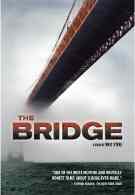I've never been a Faces of Death kind of guy. I find that whole thing distasteful. The Bridge isn't in that category but it is a distant cousin. Maybe a fourth cousin three times removed. While it tries to look deeper at the issue of suicide than most feature length documentaries and does shed some light on a painful subject, it wouldn't have any hook if those camera operators hadn't caught so many people jumping to their deaths off the Golden Gate Bridge. About once every two weeks a person walks to the middle of the Golden Gate Bridge in broad daylight, steps over the railing, and jumps to their death. Eric Steel, a movie producer living in New York, read in late 2003 about how this beautiful and imposing bridge was the most popular suicide site in the world. He then spent all of 2004 with a team of camera operators pointing two cameras at the bridge during daylight hours. They recorded 19 of the 24 bridge jumping suicides that year as well as several near misses and turned the film into a documentary exploring mental illness, hopelessness, loss, anger, and the strange allure of the world's largest suspension bridge to people at the lowest point in their lives.
In addition to the shots of people walking across and, at times, jumping off the Golden Gate Bridge, Steel interviewed friends and family members of the jumpers as well as witnesses to the event. The witnesses often express bewilderment that someone would take the action they saw. These are people with something to live for who have no concept of those who don't. The friends and family members discuss the depression and self-loathing that cause their loved ones to feel like prisoners in their own bodies.
Despite the focal point of the Golden Gate Bridge as the final stop for all these jumpers, there is nothing else tying the stories together. Steel is hampered by being unable to weave a coherent narrative or unifying theme into the stories told by friends and family; it runs all over the map. Once you get past the fact that everyone who committed suicide was depressed, there isn’t much left. The allure of the bridge isn’t really revealed or even discussed in some cases. Most of the stories aren’t much different than the after-school special on suicide you saw as a kid.
The visuals of the bridge, however, are a whole different story. There is a true shock to the actual jumps that the cameras recorded and the first one stops you cold. “Did I just see that old guy jump off the f***ing bridge?” Even eerier are the wide shots of the bridge where things are still and quiet and then in the corner of the picture you see a splash. Increasing the tension of every scene is that many, many people go to the railing and look over just to see or take a picture or think. You sit thinking “is this the one? is this the guy who is going over?” and feel a bit ghoulish. You feel fascinated watching it but a little dirty that you’re so interested.
Steel didn’t put together anything new or fresh in the understanding of suicides. The stories told about the people who jump have been heard before and the talking head format makes it feel like we’ve seen it on PBS. He is respectful with his presentation of these lives and doesn’t seem to be doing any of this just to have us say “wow, look at that.” But if it weren’t for his real life capture of these people in the act, the project wouldn’t pack any sort of wallop. It’s the visuals and tension when the cameras are pointed at the bridge that makes this a movie worth watching. This is basically an independent film and as such the level of extras is very, very limited. The quality of the picture and sound is good, which becomes important as the photography of the Golden Gate Bridge takes up a significant amount of screen time. While the long shots of the bridge and the inability of the camera operators to know who to focus on and what they would do make for occasional shaky work, the picture is always crisp and it’s very easy to tell what is going on.
The only significant extra is actually well worth watching and adds quite a bit to the movie itself. It’s an interview with Director Eric Steel and the many camera operators who spent all day, every day for an entire year pointing their cameras at the Golden Gate Bridge looking for those people who might jump off. The movie itself never makes any mention of who is filming or why and Steel’s explanation and the comments of the other camera operators is revealing.
The only failure of the featurette is that Steel fails to refer to any of the controversy the film has generated. He lied on his permit application to film and when the Golden Gate Bridge authorities found out what he had done, they were pretty pissed. Several critics have referred to the movie as a “snuff film.” None of those issues are even mentioned in passing.
Your Daily Blend of Entertainment News
Besides the trailer, the only other extra is a one minute public service announcement by Kevin Hines. Hines is interviewed in the movie because he is one of the few people who jumped off the Golden Gate Bridge and lived. He later filmed the PSA counseling against suicide and telling people to get help if they are depressed.
The cliché that this isn’t a movie for everyone was never truer. It’s shocking at times to realize you are watching a real person cause their own death. But watching the movie and the featurette together is an interesting and educational experience that includes some real tension and fascination.

